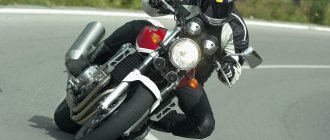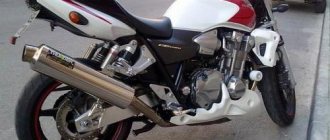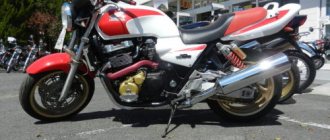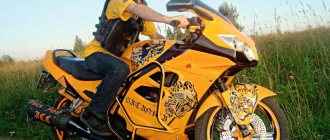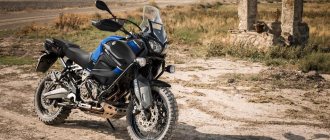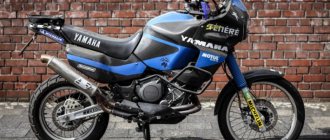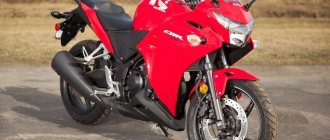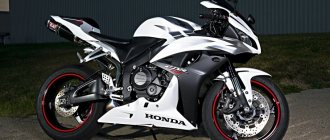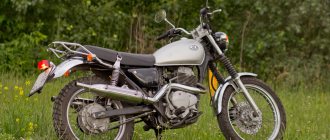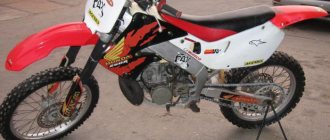| Honda CB1300 (1998-2002) | Honda CB1300 (2003-2013) | Honda CB1300 (2014-2019) | Honda CB1300S Boldor (2005-2013) |
| Honda CB1300S Boldor (2014-2019) | Honda CB1300 Super Four SP (2019+) | Honda CB1300 Super Bold'or SP (2019+) | Honda CB1300 Super Four (2021+) |
| Honda CB1300 Super Bold'or (2021+) |
Model of the classic motorcycle Honda CB 1300
was first presented in 1997 at the Tokyo Motor Show as a successor to the Honda CB 1000. Official production of the model began in 1998, the main sales market is Japan. Since 2003, the model was updated to the 2nd generation and was exported to Europe, Asia, Oceania and South America. It is noteworthy that the Honda CB1300 was never delivered to North America.
The model may be sold under the following names: Honda CB1300SF
,
Honda CB1300 Super Four
.
The basis of the Honda CB1300SF was a carburetor, in-line 4-cylinder liquid-cooled engine (SC38) with a volume of 1284 cc. see, producing 100 hp. power and almost 120 Nm of torque. The engine is identical to the one installed on the Honda X4 dragster. Subsequently, from 2003, the motorcycle received a new injection engine (SC54E) and increased maximum power to 115 hp.
Among the features of the Honda CB 1300 model, we should highlight a steel duplex frame, classic suspension in the form of a simple telescopic fork at the front and dual shock absorbers at the rear, powerful 6-piston front disc brakes (since 2001 - 4-piston), the availability of versions with ABS (since 2005 ), 5-speed gearbox (6-speed - since 2014), 21 liter fuel tank and 252-284 kg curb weight (depending on generation and version).
Main generations of Honda CB1300SF (Super Four):
- 1998-2002 - first generation
.
Models from these years are only available in the Japanese domestic market and have similar features to the Honda CB1000. Frame number: SC40
-XXXXXXX. They are distinguished by a power of 100 hp, a carburetor engine, 6-piston front calipers (since 2001 - 4-piston), a fork with a 45 mm diameter of feathers, a progressive rear suspension (Pro-Link), wide tires (130 and 190 mm) and a curb weight of 273 kg. - 2003+ - second generation
.
Models of these years are officially sold not only in Japan, but also in Europe, Asia, Oceania and some countries in South America. Visually they are distinguished by their sharp tail, 5-spoke wheels and engine appearance. Frame number: SC54
-XXXXXXX. The model receives an injection engine (maximum power 115 hp), a fork with a 43 mm diameter of stays, a new rear suspension without progression (Pro-Link), 4-piston calipers, thinner tires of 120 and 180 mm, versions with ABS, weight reduction to 252 kg and new modifications (2005: Super Bold'Or; 2009: Super Touring).
Main versions of Honda CB1300:
- Honda CB1300SF (Super Four)
- regular classic version. - Honda CB1300S / SB (Super Bold'Or)
- version with semi-fairing, rectangular headlight and glove compartments on the left and right (about 1 l). Available since 2005. - Honda CB1300ST (Super Touring)
- touring version. It is equipped with 29 liter side cases, combined brakes with ABS, a different exhaust system (which reduced the maximum power to 100 hp and torque to 113 Nm), a more powerful generator and a curb weight of 284 kg. Available from 2010 to 2014.
The company will temporarily suspend production of the CB1300 in 2022, resuming it in 2022 for the Japanese market.
At the end of October 2022, Honda introduced new modifications of the model - Honda CB1300 Super Four SP
and
Honda CB1300 Super Bold'or SP
. The modifications feature more expensive equipment, in particular Öhlins suspensions and Brembo monoblock front brakes.
On December 21, 2022, the company releases the new generation CB1300. The main changes affected the electronic equipment of the motorcycle - in particular, an electronic throttle (Ride-by-Wire), cruise control, Ride Mode, HSTC (Honda Selectable Torque Control) and a quickshifter were added as an option. In addition, the engine settings, weight and dimensions of the motorcycle and the rear brake changed (disc diameter was reduced from 276 to 256 mm).
Honda CB1300: electronic equipment
- ABS - since 2003
- LED headlight - since 2014
- Slipper clutch and clutch assist (Assist & Slipper clutch) - from 2022 (from October 2017)
- Heated grips - from 2022 (from October 2017)
- Electronic Throttle (Ride-by-Wire) - from 2021
- 3 Riding Mode - from 2022
- HSTC (Honda Selectable Torque Control) - from 2022
- Cruise control - from 2022
- Quick-shifter (optional) - from 2022
The main competitors of the Honda CB 1300 in the class:
- Kawasaki ZRX 1200
- Suzuki GSF 1200 Bandit / 1250 Bandit
- Suzuki GSX 1200 Inazuma / Suzuki GSX 1400
- Yamaha XJR 1300
000_moto_0811_038
Honda CB1300: neoclassic, 1997 - present, 1284 cm³, 246 kg, RUB 150,000–360,000.
Honda CB1300: neoclassic, 1997 - present, 1284 cm³, 246 kg, RUB 150,000–360,000.
STORY. Neoclassics, that is, motorcycles that are classic in form and essence, are a rather conservative segment. Probably even more so than custom cars and cruisers. The fine line between neoclassic and roadster is quite blurred, but its main meaning lies in the traditional design and appearance. That is why the appearance of the CB1300 was not the phenomenon of a completely new model, but a systematic development of the CB1000 Super Four theme. Compared to its predecessor, the Sibikha engine capacity increased from 998 to 1284 cm³, and the power increased from 98 hp. at 8500 rpm up to 114 hp. at 7500 rpm, and torque from 84 Nm at 6000 rpm to 117 Nm at the same speed. Of course, the thrust has increased not only in the peak value, but throughout the entire rev range. The appearance was slightly refreshed without making any drastic changes. It is too easy to scare off a potential buyer, because if you go too far with technical, layout or stylistic solutions, the motorcycle will jump from neoclassics to roadsters, and this is a completely different topic and a different contingent of buyers. The motorcycle was equipped with six-piston calipers on the front wheel, a fork with supporting pipes with a diameter of 45 mm, and the rear suspension acquired a “progression” (each of the two shock absorbers was connected to the pendulum via a rocker arm). Four carburetors were responsible for mixture formation.
The second generation SV1300 was released in 2002. The motorcycle has remained virtually unchanged in appearance, but has undergone a fairly serious modernization. Instead of carburetors, the PGM-FI injection system began to prepare the mixture (by the way, the manual starting enricher still remained), the fork “shrinked” to 43 mm, and instead of six-piston calipers, four-piston ones were installed. “Progression” was removed from the rear suspension design, securing the shock absorbers directly to the pendulum. The first generation of the motorcycle was sold only on the domestic Japanese market, but the second generation has already “gone around the world.” Official sales have started in many countries around the world, including Russia.
Release Features
Honda CB1300SF 1998-2002.
Honda CB1300SF 2003+.
Following this concept, of the naked bike began 1998 . Seven years later, a model with a front fairing appears. Like the 400, the modifications are respectively named Super Four and Boldor .
Production of both versions continues. Over its 20-year history, the bike has gone through one generation.
In addition, some cosmetic changes are made almost every year. The filling basically remains the same.
The position of marketers regarding generations is curious. The first is to sell only in Japan. The following is also for export. It is noteworthy that North America (USA and neighboring countries) is missing from foreign markets.
The motorcycle pleases with excellent dynamics, excellent handling and amazing versatility.
Since the model is still in development, a Russian user, if he is not bothered by delivery from abroad, can order a brand new Sibikha for an amount starting from $7,000 . And since the production of the bike did not start yesterday, there are options on the secondary market. The cost of a model with mileage in the Russian Federation starts from 150 thousand rubles , without - $3,500 and above.
001_moto_0811_038
Honda CB1300 Super Four, 1997 The first generation CB1300 is easily distinguished from its predecessor by 17-inch wheels, a lower profile, decorative cooling fins on the sides of the cylinder block and two exhaust pipes instead of one per “liter”.
Honda CB1300 Super Four, 1997 The first generation CB1300 is easily distinguished from its predecessor by 17-inch wheels, a lower profile, decorative cooling fins on the sides of the cylinder block and two exhaust pipes instead of one per “liter”.
002_moto_0811_038
Honda X4 LD, 1999 X4 is a power cruiser built on the basis of the CB1300.
It was developed as Yamaha's response to its mega-popular V-Max. The engine and transmission of the X are completely identical to those of the first generation, only larger jets were installed in the carburetors to improve acceleration dynamics. The motorcycle was sold only in Japan and lost the market battle with the V-Max. It was discontinued in 2002. Honda X4 LD, 1999 X4 is a power cruiser built on the basis of the CB1300. It was developed as Yamaha's response to its mega-popular V-Max. The engine and transmission of the X are completely identical to those of the first generation, only larger jets were installed in the carburetors to improve acceleration dynamics. The motorcycle was sold only in Japan and lost the market battle with the V-Max. It was discontinued in 2002.
and competitors
Competitors also presented their developments, while Suzuki distinguished itself with as many as 4 versions. What is curious is that all four belong to the class of road workers. This:
- GSF 1200 Bandit.
- GSF 1250 Bandit.
- GSX 1200 Inazuma.
- GSX 1400.
The rest were not so prolific and offered 1 motorcycle each:
- Kawasaki ZRX 1200;
- Yamaha XJR 1300.
Honda itself was thinking about putting out a dragster, which was mentioned just above, but abandoned the idea, citing the fact that for this it would have to be introduced to the world market, and it was created for itself - only for Japan .
003_moto_0811_038
Honda CB1300 F, 2002. The motorcycle has undergone a slight facelift, the shape of the tank and “tail” have changed.
The second generation is distinguished by the presence of fuel injection, a thinner fork, and the absence of “progression” at the rear. Externally, the easiest way to distinguish the “second” SV1300 from the “first” is by the absence of ribs on the cylinder block, chrome-plated camshaft plugs on the cylinder head and one muffler instead of two. Honda CB1300 F, 2002. The motorcycle has undergone a slight facelift, the shape of the tank and “tail” have changed. The second generation is distinguished by the presence of fuel injection, a thinner fork, and the absence of “progression” at the rear. Externally, the easiest way to distinguish the “second” SV1300 from the “first” is by the absence of ribs on the cylinder block, chrome-plated camshaft plugs on the cylinder head and one muffler instead of two.
004_moto_0811_038
Honda CB1300 Bol d'Or, 2004. The CB1300 Bol d'Or version differs from the base version by the presence of a “bikini” fairing with mirrors on plastic and a rectangular headlight.
Honda CB1300 Bol d'Or, 2004. The CB1300 Bol d'Or version differs from the base version by the presence of a “bikini” fairing with mirrors on plastic and a rectangular headlight.
FOR WHAT? It is quite difficult to talk about the purpose of the great classic. First of all, this is a motorcycle for every day, but not for everyone. Most often they are bought by motorcyclists aged 35 and older, who are already experienced enough not to experience problems with a heavy machine, and who do not require “space” characteristics from the device. High speeds are not the Seabee's strong point. And although the engine easily accelerates a heavy projectile to 230-240 km/h and in three seconds to “hundred”, the heavy weight, steel frame, simple rear suspension and modest fork parameters do not allow driving really aggressively. This is a device for calm but dynamic movement in space, offering a fair level of comfort and a reserve of torque. It will be quite comfortable in the city crowd (unless, of course, the pilot is a featherweight) and on a country highway. It will not save even on a broken road. The main thing to remember when choosing the CB1300, like any other neoclassic, is that this is not a sports lighter, but a “big car with a powerful engine” like the Cadillacs and Buicks of the middle of the last century.
WHERE TO LOOK? Quite a large number of SV1300 are sold in Russia. Moreover, both sellers of Japanese second-hand stores and private traders selling their motorcycles have vehicles of all years of manufacture and modifications. Officials stopped selling Seabihs several years ago, but it’s not difficult to find a new vehicle with a domestic dealer’s seal in the service book. Considering the specifics of the motorcycle and the contingent that most often rides it, we can safely recommend looking for copies of all years of manufacture. The most reliable design and calm manner of operation of the device make it almost eternal. There are practically no motorcycles that are trashed, so there is always plenty to choose from. It is only important to decide on the generation. The first version of the “Sibihi”, although carbureted, has a more powerful fork, progression in the rear suspension and excellent brakes; the second, although with worse brakes and chassis, will not require regular cleaning and synchronization of carburetors. In terms of driving performance, both options are similar, but the “second” one is a little easier to control at low speeds.
WHAT TO WATCH FIRST AND WHAT TO FOLLOW LATER?
"!" It is worth paying attention to the rear suspension progression system (first generation). Over time, the silent blocks of the “rocking chairs”, through which the pendulum is connected to the shock absorbers, break, begin to play and creak, especially after water procedures. In general, the problem is not so critical, but it can only be cured by replacing the silent blocks. A set of rubber bands lasts two years on average.
"!" The first generation Seabihi fork The motorcycle nods a lot when braking, is prone to longitudinal rocking while moving and, of course, does not “hold” turns very well. Sibikhovods recommend immediately replacing the standard springs with tuning springs with progressive characteristics, for example, from the company Progressive Suspension. In the second generation, this problem is not so pronounced, however, the “second” “sibikha” should carry out the same replacement. The quality of the suspension will only improve. It is also recommended to set the rear shock absorber spring preload to maximum. All these measures will significantly “ennoble” the behavior of the motorcycle at high speeds.
“-” All neoclassics of the CB series from “four hundred” to “three hundred liters” are equipped with different shock absorbers of a backpack design from Showa. They all have the same “disease” - they leak over time. Honda considers them non-separable and suggests replacing them with new ones. The original unit is very expensive (see spare parts table), but alternative options can be found. In addition, specialized companies in Moscow and other cities for 6–10 thousand rubles. They will undertake to completely overhaul the shock absorber, replace all seals, bronze bushings and oil. In any case, when choosing a motorcycle, you need to pay special attention to checking the shock absorbers for leaks.
“+” Since the first generation of the Seabihi was sold only in Japan, all motorcycles had an electronic speed limit of 180 km/h. Craftsmen have learned how to remove this blockage, so when buying a motorcycle, it is worth asking whether the motorcycle is “spirited.” The cost of work on “unventing” is usually approximately 4-5 thousand rubles.
“-” Surprisingly, it can be difficult to find an air filter , so you should take care of purchasing it in advance. An option is to install a serviceable, reusable zero-resistance filter from K&N, however, as practice shows, Kaen’s “zero” filters clean the air much worse than the standard ones, which reduces the engine’s service life.
"!" A characteristic feature of the SV1300 engine is increased timing noise . This is considered the norm and it is impossible to get rid of it. Neither replacing the rocker arms nor adjusting the thermal clearances of the valves helps. If in doubt, it is worth inviting an experienced mechanic who can catch abnormal noises (for example, from unadjusted valves) in the general background noise.
“+” It’s good if the selected device has roll bars . In case of falls, the first to be affected are the side covers of the engine, which protrude quite far beyond the dimensions of the frame. But “Sibihe” sliders can only do harm. They still won’t save the engine covers, and they can easily bend the aluminum brackets for the front engine mounting to the frame. The bracket cannot be straightened, so even the most harmless fall can result not only in replacing the covers, but also in a long wait for new engine brackets. Sellers almost never have them in stock.
TUNING. Tuning a neoclassic is a scarce topic, primarily because people who want to stand out or simply have a penchant for individualization rarely choose a neoclassic in general and a “Seabihu” in particular. Not all aftermarket manufacturers produce any body kit for this motorcycle. This is especially true for the first version, which was sold only in Japan. Finding a windshield or a kit for installing a pannier on it is quite a serious problem. You have to be content with universal glasses, cases, etc. The “second” version, which has international status, is much more favored by tuning manufacturers. For example, Givi offers both pannier systems and windshields specifically for the CB1300. Keep in mind that despite the external similarity, tuning intended for the second generation often does not fit the first.
Due to the large mass and rather “stupid” geometry, the motorcycle is quite reluctant to maneuver. Experienced seabreeders advise installing tires on the motorcycle with a profile smaller than the standard one: instead of 130/70-17 in the front - 130/55-17, and instead of 190/60-17 in the rear - 190/55-17. Of course, with “sports” wheels the smoothness of the ride drops somewhat, but the motorcycle listens to the pilot much better.
PRICES. Prices for "sibikha" vary from 150-160 thousand rubles. for devices of the first years of production, which were already quite similar in Russia and up to 340–360 thousand rubles. for practically new motorcycles produced in 2008–2010, with minimal mileage. Often you come across vehicles with almost zero mileage, which are sold by very respectable people for the reason “bought a couple of years ago, traveled twice, no time to ride.” In most cases, a used motorcycle is in quite decent technical and external condition; like the first one, they almost never buy it, and young hot guys who can beat the machine into meat in a season or two more often choose motorcycles that are more powerful and aggressive. The presence of tuning has a slight effect on the price, since almost all “used” Seabihs are equipped approximately the same: a trunk, a windshield, heated handles, baubles, in different variations are found on almost everyone. Selling such a motorcycle will not be difficult either. There is always a demand for a big classic, and the price for an “eternal” motorcycle does not fall much, unless, of course, it bears traces of encounters with asphalt.
History of changes
During its career, this motorcycle went through several stages:
- 1998 – launch of production, first generation;
- 1999 – the central stand appears;
- 2001 – reduction in fuel consumption;
- 2003 – second generation, global changes;
- 2008 – new catalyst.
Since then, the CB 1300 has not changed much. This motorcycle is perfect for connoisseurs of the best that has been tested for decades, because it has everything to evoke the best memories of motorcycle riding veterans. Taking all the best from the old school, the model meets modern standards.
018_moto_0811_038
Suzuki GSX1400: neoclassic, 2001–2006, 1402 cm³, 106 hp, 228 kg, 200,000–420,000 rub.
Suzuki GSX1400: neoclassic, 2001–2006, 1402 cm³, 106 hp, 228 kg, 200,000–420,000 rub.
| Estimated cost of spare parts for Honda CB1300 | ||
| Name | Original spare parts, rub. | Non-original spare parts, rub. |
| Silent blocks of the rear suspension progression system (set) | 2400 | — |
| Air filter | 2000 | 1980 (K&N) |
| Fork springs (set) | — | $92* (Progressive Suspension) |
| Rear shock absorbers (set) | 62 000 | 25 600 |
| Right engine cover | 7900 | — |
| Left engine cover | 7200 | — |
| Protective arches | — | 5140 (Crazy Iron) |
| *Excluding shipping costs. | ||
| Spare parts, mostly available in stock. | ||
| Spare parts are sometimes in stock. | ||
| Spare parts, mainly imported to order. | ||
We thank the PM-Moto workshop for their help in preparing the material.
Classic classic: Honda CB1300
